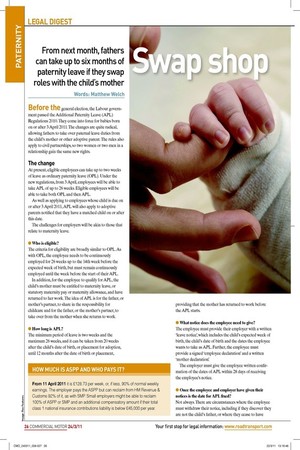Swap shop
Page 20

Page 21

If you've noticed an error in this article please click here to report it so we can fix it.
From next month, fathers can take up to six months of paternity leave if they swap roles with the child’s mother
Words: Matthew Welch Before the general election, the Labour government passed the Additional Paternity Leave (APL) Regulations 2010. They come into force for babies born on or after 3 April 2011. The changes are quite radical, allowing fathers to take over paternal leave duties from the child’s mother or other adoptive parent. The rules also apply to civil partnerships, so two women or two men in a relationship gain the same new rights.
The change
At present, eligible employees can take up to two weeks of leave as ordinary paternity leave (OPL). Under the new regulations, from 3 April, employees will be able to take APL of up to 26 weeks. Eligible employees will be able to take both OPL and then APL.
As well as applying to employees whose child is due on or after 3 April 2011, APL will also apply to adoptive parents notiied that they have a matched child on or after this date.
The challenges for employers will be akin to those that relate to maternity leave.
● Who is eligible?
The criteria for eligibility are broadly similar to OPL. As with OPL, the employee needs to be continuously employed for 26 weeks up to the 14th week before the expected week of birth, but must remain continuously employed until the week before the start of their APL.
In addition, for the employee to qualify for APL, the child’s mother must be entitled to maternity leave, or statutory maternity pay or maternity allowance, and have returned to her work. The idea of APL is for the father, or mother’s partner, to share in the responsibility for childcare and for the father, or the mother’s partner, to take over from the mother when she returns to work.
● How long is APL?
The minimum period of leave is two weeks and the maximum 26 weeks, and it can be taken from 20 weeks after the child’s date of birth, or placement for adoption, until 12 months after the date of birth or placement, providing that the mother has returned to work before the APL starts.
● What notice does the employee need to give? The employee must provide their employer with a written ‘leave notice’, which includes the child’s expected week of birth, the child’s date of birth and the dates the employee wants to take as APL. Further, the employee must provide a signed ‘employee declaration’ and a written ‘mother declaration’.
The employer must give the employee written conirmation of the dates of APL within 28 days of receiving the employee’s notice.
● Once the employee and employer have given their notices is the date for APL ixed?
Not always. There are circumstances where the employee must withdraw their notice, including if they discover they are not the child’s father, or where they cease to have responsibility for bringing up the child; or where the mother has not returned to work.
The employee can change the dates of their APL providing the APL has not yet started and they give the employer six weeks’ notice. The employee can return to work earlier providing they give at least six weeks’ notice.
● What happens if the employee’s job becomes redundant while they are on APL?
Employees on APL are treated as favourably as women on maternity leave. They go to the head of the queue and have to be offered, before other employees, any suitable alternative employment.
Failure to offer alternative employment to an employee on APL whose job has become redundant will make the employee’s dismissal automatically unfair.
● Does the employee have to return to their old job? The regulations are quite complex but essentially, as with maternity leave, the employee should not be put at a disadvantage by taking APL and is entitled to return to their old job, with their seniority, pension rights and other contractual rights as they would have been, had they not been on APL.
● What paternity pay are they entitled to receive? Employees on APL are entitled to receive Additional Statutory Paternity Pay (ASPP) providing they comply with the eligibility and notiication criteria and a low-earn ings limit. ASPP can be claimed from the date APL starts, which will be when the child is 20 weeks old. It inishes on the child’s irst birthday or the end of the mother’s maternity allowance or Statutory Maternity Pay (SMP) period, whichever is the earlier. The idea is that, in effect, the employee on APL takes over the mother’s SMP.
● APL will be disruptive to the business. Is there anything I can do?
There is very little you can do and you need to be careful how you deal with employees applying for or taking APL, because if a dismissal is connected with the employee taking or seeking OPL or APL it will be automatically unfair. An employee can also bring a tribunal claim for compensation if they can show they have suffered a detriment, such as loss of pay or beneits, being unfairly disciplined or demoted. ■ ● Matthew Welch, is a solicitor at Bath Law. matthew@bathlaw.com.
Further Information
http://bit.Ly/cBVvFU














































